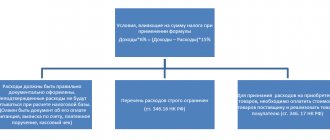What is income?
The term “income” refers not only to cash, but also to material assets that, for example, a company receives over a certain period of time. In other words, this is the total amount of all income, which includes even fines collected, interest received on deposits, etc., and not just the result of the enterprise’s activities.
REFERENCE!
Income can be received by individuals and legal entities, as well as the state.
There are cases when income does not require investment of funds (receiving a pension, subsidy, etc.).
It is also important to know that income can be unplanned, for example, when the counterparty violated the terms of the contract and paid a penalty for this.
From what income is child support not withheld?
In Art. 84 of the RF IC provides a reference to the Decree of the Government of the Russian Federation No. 841 of July 18, 1996. This document provides a comprehensive list of income from which alimony is withheld. And here are the incomes that qualify as exceptions :
- survivor's pension;
- compensation for the death of a relative or the birth of a child;
- travel and other payments that cover work expenses.
But that's not all. There is also Federal Law No. 229-FZ “On Enforcement Proceedings” dated October 2, 2007. Art. 101 is devoted to income from which no collection can be made, including withholding of alimony:
- compensation payments for wear and tear of working tools;
- compensation for industrial injuries and occupational diseases;
- material assistance: birth of a child, marriage, natural disaster, terrorist attack, humanitarian assistance;
- compensation for vouchers to health institutions for the payer and children under 16 years of age;
- maternal capital;
- compulsory insurance coverage;
- alimony received by the payer himself;
- financial assistance for funerals.
As you can see, the list is not that big. What's not included? You probably noticed that the list does not include payment for sick leave. From temporary disability benefits, alimony is withheld in full.
What is the difference between income and profit?
Unlike income, it is profit that reflects the efficiency of commercial activities, due to which the value of this indicator will always be less than income. Therefore, the term “profit” can be characterized as follows: the difference between total cash receipts and expenses for a certain reporting period. Shareholders are interested in this particular indicator, since dividends are paid from profits.
When calculating profit, both main and additional activities are taken into account.
REFERENCE!
Profit can be not only positive, but also zero and even negative. In the last two cases, the result of the activity is a loss.
Profit is divided into several categories:
- accounting;
- economic;
- arithmetic;
- normal;
- economic
How much alimony is collected?
If agreement on the payment of alimony is not reached between the parents, alimony is collected by the court.
Their size is determined in paragraph 1 of Art. 81 of the RF IC: for one child - 1/4, for two children - 1/3, for three or more children - 1/2 of the earnings or other income of the parents. The size of these shares may be reduced or increased by the court, taking into account the financial or family situation of the parties and other noteworthy circumstances (clause 2). Collection of alimony for the maintenance of minor children in court can be carried out not only in shares of the earnings of the parent from whom alimony is collected, but also in a fixed sum of money.
According to paragraph 1 of Art. 83 of the RF IC, the court has the right to determine the amount of alimony collected monthly in a fixed sum of money (or simultaneously in shares and a fixed sum of money), if the parent obligated to pay alimony:
- has irregular, fluctuating earnings or other income;
- receives earnings or other income wholly or partially in kind or in foreign currency;
- has no earnings or other income;
- in other cases, when the collection of alimony in proportion to the earnings or other income of the parent is impossible, difficult or significantly violates the interests of one of the parties.
How are revenue, income and expenses determined?
There are two methods that help determine revenue, income and expenses:
- By shipment. All indicators are calculated at the time of provision of a specific service or several services at once, as well as when performing work or transferring inventory items (inventory).
- Upon payment. The most commonly used method. The indicator is determined after all calculations have been made. Most suitable for small and medium-sized businesses, such as retail stores. The only drawback of this method is the lack of ability to control accounts receivable and payable, and all because only received funds are taken into account, without data on goods sold, services provided and work performed.
Types of income - gross and net
Gross - the total amount of revenue for a certain reporting period, which takes into account absolutely all types of income. The size of the gross indicator is mainly influenced by the following factors:
- volume and range of goods produced or services provided;
- trade price premium and its economic justification;
- the quality of additional services provided and their quantity;
- selection of counterparties and the cost of purchased goods/services, as well as methods of payment.
To calculate the gross indicator, several methods are usually used:
- by trade turnover and its assortment;
- according to the assortment of the remainder of a certain type of product;
- by average percentage.
Net income is the amount that remains at your disposal after making all necessary payments (for example, paying taxes, interest on a loan, paying employees, etc.).
Revenue - simple and clear
Revenue is mentioned as one of the forms of income of a business. This is a simpler economic concept than income.
Revenue is money received as payment for goods sold or services provided. If you do not take into account mandatory deductions from it in the form of taxes, excise taxes, duties already included in the price of the product, such revenue is considered gross . The funds from which all these indicators have already been extracted will constitute net revenue . This is what will need to be indicated in the accounting documents.
Money received by a business is not necessarily immediately considered revenue. The moment at which it is recognized as such is of key importance and depends on the chosen accounting method.
- Cash accounting . Revenue equals payment. For a product or service, money was received at the cash desk, which is recorded by a cash register or a strict reporting form. With this method, advances and deposits will be considered revenue, but deferred payments will not immediately be included in it.
- Revenue by accrual . Funds are recognized as revenue when the goods are transferred to the buyer or a certificate of services rendered is signed. In this case, it does not matter when the money actually arrives at the cash desk; formally, it is already considered to belong to the organization. In such situations, the advance will not be included in the revenue.
Other types and sources
In addition, you can also identify several types of income and sources of their receipt.
simplified tax system income
STS income is a special type of profit to which a simplified taxation system (or a special procedure for paying taxes) is applied. This scheme is mainly aimed at small and medium-sized businesses. Income from the simplified tax system is determined in accordance with articles 346.15 and 346.17 of the Tax Code of the Russian Federation; this can be revenue from the sale of services, goods, rights, etc.
Income tax
According to the legislation of the Russian Federation, any income must be taxed, no matter who receives it, an individual or a legal entity. The only difference is that in some cases, the tax is paid for an individual by an organization from which it receives officially and documented funds (for example, wages or dividends).
Each category of taxpayer and type of funds received has its own tax rates; most often in Russia they range from 13% to 15%. The size of such a payment can be obtained by multiplying the tax base by the rate.
Budget revenues
Budget revenues are funds whose sources are:
- Taxes.
- Fees.
- Foreign loans.
- Foreign economic activity.
- Sale of land.
- Sales of government reserves, etc.
This type is used exclusively for government activities:
- legal;
- political;
- organizational;
- social;
- economic;
- cultural;
- educational;
- environmental.
The material basis of all budget revenues is national income. The structure of the type in question may be subject to changes that depend on the current economic situation in the country.
Article 248 of the Tax Code of the Russian Federation. The procedure for determining income. Income classification (current version)
The object of taxation for corporate income tax is revenue from the sale of goods, work, services, property rights and non-operating income, reduced by the amount of expenses incurred in the manner established by the Tax Code of the Russian Federation.
The concepts of income from sales and non-operating income are defined respectively in Articles 249 and 250 of the Tax Code of the Russian Federation.
Income is determined on the basis of primary and other documents confirming the income received by the taxpayer, and tax accounting documents.
According to the general rule established in Chapter 25 of the Tax Code of the Russian Federation, when determining income for profit tax purposes, the amounts of taxes presented by the taxpayer to the buyer (acquirer) of goods (work, services, property rights) are excluded from them.
Article 311 of the Tax Code of the Russian Federation also establishes that expenses incurred by a Russian organization in connection with the receipt of income from sources outside the Russian Federation are deducted when determining the tax base in the manner and amount established by Chapter 25 of the Tax Code of the Russian Federation.
When applying paragraph 2 of Article 248 of the Tax Code of the Russian Federation, it should be taken into account that, within the meaning of Articles 415 and 423 of the Civil Code of the Russian Federation, debt forgiveness is a gratuitous transaction, since the creditor’s waiver of the right to claim is not conditioned by any counter-provision on the part of the debtor.
Funds received under a loan agreement and remaining at the disposal of the organization as a result of an agreement with the lender on debt forgiveness are considered for profit tax purposes as received free of charge.
This position is adhered to by the Russian Ministry of Finance in letter dated October 11, 2011 N 03-03-06/1/652.
The situation when goods are provided free of charge, this indicates the existence of a relationship between the parties under a gift agreement, which means that the donee has received property free of charge.
At the same time, Article 575 of the Civil Code of the Russian Federation indicates cases when donation is not allowed.
Tax accounting of property received free of charge by an organization must be carried out in the manner established by Chapter 25 of the Tax Code of the Russian Federation.
The Ministry of Finance of Russia in letters dated September 15, 2005 N 03-03-04/1/190 and dated November 14, 2005 N 03-03-04/1/354 indicated that if, due to the fulfillment of certain conditions of the contract, the seller pays (provides) a premium to the buyer (discount), for the buyer such a discount will be property received free of charge, subject to inclusion in the tax base for corporate income tax.
According to the provisions of Article 567 of the Civil Code of the Russian Federation, under an exchange agreement, each party undertakes to transfer one product into the ownership of the other party in exchange for another.
Accordingly, the rules on purchase and sale are applied to the exchange agreement, if this does not contradict the rules of Chapter 31 of the Civil Code of the Russian Federation and the essence of the exchange. In this case, each party is recognized as the seller of the goods, which it undertakes to transfer, and the buyer of the goods, which it undertakes to accept in exchange.
Taking into account the above, as well as the fact that the rules on purchase and sale apply to legal relations arising in connection with the conclusion of an exchange agreement, the property received under the above agreement is not received free of charge.
A similar position is given in the letter of the Ministry of Finance of Russia dated March 30, 2010 N 03-03-06/2/61.
In the event that property is received as compensation to account for the debt incurred under the contract, such transfer is of a compensated nature. In addition, the mere fact that the book value of the transferred property does not correspond to the price of the original transaction does not indicate the gratuitous nature of such a transfer (see, for example, Resolution of the Federal Antimonopoly Service of the North Caucasus District dated September 24, 2009 N A32-14927/2008-51/113).
When applying paragraph 3 of Article 248 of the Tax Code of the Russian Federation, it should be taken into account that income once taken into account for profit tax purposes is no longer subject to inclusion in the calculation of the tax base.
Comment source:
“ARTICLE-BY-ARTICLE COMMENTARY TO CHAPTER 25 OF THE TAX CODE OF THE RUSSIAN FEDERATION “CORPORATE PROFIT TAX” (UPDATED)
Yu.M. Lermontov, 2012
Income accounting
Accounting for the profit of each organization is carried out on the basis of Order No. 32n of the Ministry of Finance of the Russian Federation. 86n and 25 chapters of the Tax Code of the Russian Federation. For each company, depending on its activities and the type of funds received, there is its own calculation and accounting procedure. So, for example, individual entrepreneurs must keep a special book, and enterprises keep such records on accounting accounts 90 and 91. For any violations in accounting, legal entities are subject to fines.
Income book
The Income Book is the most important tax register for individual entrepreneurs. Its maintenance is carried out on the basis of the rules prescribed in Order No. 135n of the Ministry of Finance of Russia. It indicates all cash receipts and expenses of individual entrepreneurs who use the simplified tax system or the patent system. Each taxpayer must ensure continuity, reliability and, of course, completeness of the data provided. Each transaction entered consists of the date of the transaction, the transaction itself, the total amount and other information.
The book is maintained according to the following rules:
- For each new tax period, a new book is opened.
- The book can be kept either electronically or in paper form, but when using the first method, it must be transferred to paper at the end of the tax period.
- Each entry must have documentary evidence.
- Entries must be reflected in full ruble equivalent.
- The absence of activity or operations does not exempt from the formation of a document; in this case, the individual entrepreneur must have a zero book.
- You do not need to submit the book to the tax authority every time, but you should definitely have it in case of unplanned audits.
REFERENCE!
If during the inspection the individual entrepreneur does not have a book, then he will be fined. The book must be stored for four years.
Voluntary payment of alimony
The responsibility of parents to support minor children is spelled out in paragraph 1 of Art.
80 IC RF. Child support can be paid voluntarily, both on the basis of an agreement concluded between the parents, and without it. The agreement must be in writing and certified by a notary. In this case, it has the force of a writ of execution. If the established form is not observed, the agreement is considered void.
The agreement can be changed or terminated at any time by mutual agreement of the parties, which must also be notarized. This follows from Art. 100–101 RF IC. If the agreement is presented at the place of work, the employer is obliged to withhold alimony from the salary or other income of the employee paying the alimony and transfer it to the recipient.
Payment of child support can occur voluntarily and in the absence of a notarized agreement on the payment of alimony, but only on the basis of an application from the employee with a request to withhold alimony from him.
Editor's note: at the request of the employee, it is allowed to withhold any amounts without restrictions, but only after withholding personal income tax and amounts under executive documents (letter of Rostrud dated September 26, 2012 No. PG/7156-6-1).
Declaration of income
According to Federal Law No. 118, all citizens of the country must annually submit a tax return to the relevant authorities at their place of residence. A declaration is understood as a statement drawn up in the form of the tax authority, which indicates all income and expenses, tax benefits and the calculated amount of tax. But there are also exceptions that exempt the following categories of the population from this procedure:
- persons who do not have a permanent place of residence in the Russian Federation;
- persons who receive money during a certain reporting period only at the place of employment;
- persons receiving funds, the total amount of which does not exceed the taxable amount.
Per capita income
The concept of “per capita income” implies the economic well-being of the state and its citizens. It measures the average income an individual earns in one calendar year. This indicator is calculated by dividing national income by population.
Using this value, the economic development of the state is judged, thanks to which the place in various ratings is determined. But this indicator has a weak point, because its characteristics do not take into account imbalances in the distribution of funds among different segments of the population.
IMPORTANT!
For cross-national comparisons, this indicator is converted into dollars, and the purchasing power of citizens is used to obtain an accurate assessment of the economic situation of a particular state.
How to count
To determine whether a family is low-income, it is necessary to calculate the average per capita income. The procedure for its calculation is established by Federal Law No. 44-FZ dated 04/05/2003. The answer to the question of what income a low-income family should have per person in 2022 is less than the subsistence level established in the region of residence.
There are exceptions to this rule. For example, to receive “Putin’s” payments established by Federal Law No. 418-FZ of December 28, 2017, you need earnings not exceeding 2 times the subsistence minimum.
The formula for calculating whether a family is low-income in 2022 looks like this:
In accordance with Art. 4 44-FZ, average income is calculated for a period of three months, the variable Km in such cases is equal to 3, and the calculation takes into account income for the last three months. In some cases, the calculation period is recognized as a year.
The unified portal of public services provides a special service for calculating per capita family income. Check whether government benefits, subsidies and compensation are eligible.
Use free instructions from ConsultantPlus experts to apply for any benefit:
- on unemployment;
- for pregnancy;
- children's and others.
Passive income
Passive income is funds the receipt of which is not related to work activity, that is, you can receive money of this type regardless of age, health and activity. Moreover, it is also subject to tax, paid once a year. The main sources of passive income can be:
- Renting out any type of property (buildings, equipment, vehicles, etc.).
- Non-state pension. It is formed by concluding an additional pension agreement. That is, an individual, before the deadline for assigning a pension, makes regular contributions to the fund (NPF), and after reaching a certain age, which will be specified in the contract, he will gradually begin to receive them along with the official pension.
- An open deposit in a bank that can generate profit both monthly and only after the end of the period specified in the agreement.
- Investments in securities (for example, stocks, bonds, etc.). This method can be a good source of additional profit. But in this case, it is necessary to take into account that the possibility of obtaining additional funds is directly proportional to the risk, that is, the greater the profit, the higher the risk. Therefore, it is always recommended for beginners to start with proven and more predictable tools.
- Investment life insurance. In this case, the investment will be handled by an insurance company, with which an agreement is concluded for a period of 3 to 5 years. During this time, it is necessary to make one or more contributions, the amount of which will be returned along with the accumulated investment income after the end of the agreement. Insurance companies can also offer more or less risky strategies, which will determine the amount of profit.
- Crowdfunding. This method is less common, but is still sometimes used. It involves investing money in someone else’s business, if it is fast-growing, then you can get a considerable amount out of it, but at the same time you can lose everything in one moment. Therefore, it is not recommended to invest all your money in such projects.
- Intellectual property. Suitable for creative people who, thanks to their talent (writing a book, song, patenting an ingenious device, etc.) will be able to make a profit of various sizes.





